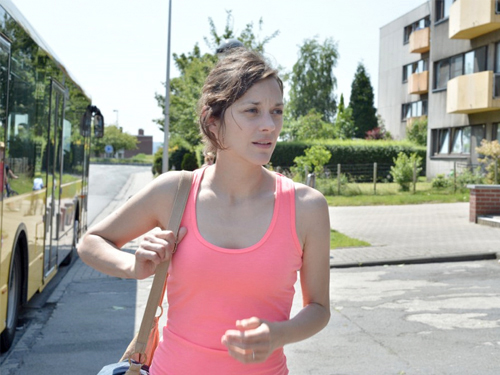
The film follows Sandra, a young woman assisted by her husband, who has only one weekend to convince her colleagues to give up their bonuses so that she can keep her job.
Leslie Charreau: Two Days, One Night is sort of like the Dardenne brothers’ version of 12 Angry Men, isn’t it?
Alain Marcoen: It is true that one might draw a relationship between Sydney Lumet’s film and this one, particularly due to its “alone against the entire world” aspect. But where the two movies diverge, in my opinion, is in the importance they accord to movement. Let me explain: in many of the Dardenne brothers’ films the main character’s conflict is resolved via the path he takes – such as in Rosetta or The Kid with a Bike. It reminds me of the basic myth of the “walking man” as shot by Etienne Jules Marey or Eadweard Muybridge, and I find this very moving.
It’s pretty rare in a Dardenne brothers’ film, but Two Days, One Night is bursting with sunshine. There’s even an almost Western atmosphere in the last scene…
The brothers wanted a summer film. We shot for eleven weeks during the heart of the summer in 2013. The weather that summer was particularly hot for Belgium! You can feel it in the film, in the visuals, the costumes… such as the pink tank top worn by Marion for the whole first day of the story. You can see the sweat on their faces. The issue for me and the gaffer and the key grip was how to manage the very harsh sunlight. Although Marion never made any aesthetic demands regarding the film, I felt obliged, out of a sense of gallantry, to protect her face most of the time by showing the Brothers during screen tests that the sun could produce overly-harsh visuals. Most of the outdoor daytime shots became an uphill battle fought using diffusion frames, large silks, and camouflage nets (such as in the scene in the rear courtyard with the millstone) in order to allow us to shoot at any time, whilst maintaing relatively soft lighting on the faces. I would also like to acknowledge the amazing, precise work done by Amaury Duquesne, especially given that I chose to shoot most of the time at 4.5 in order to focus in on Marion against the landscape. This led to visuals radically different from those in The Kid with a Bike, where I had chosen a more “polaroid” sort of image with diaphragms ranging between 8 and 11.
Leslie Charreau in conversation with Alain Marcoen (DOP of Deux jours, une nuit)1
“Vechten is belangrijk, dan blijf je leven. Anders lag ze nog altijd in haar bed. Door de ervaring ontdekte ze solidariteit, veranderde ze en durfde ze ‘nee’ zeggen. De Sandra van het begin was misschien ook niet solidair geweest wanneer ze zich in de positie van haar collega’s had bevonden. Maar aan het slot is ze veranderd. Want wat ze doet is niet evident, ze zit uiteindelijk wel zonder werk. Het is verschrikkelijk om zich in haar fragiele positie te bevinden. Het is Mr. Dumont die beslist, die de macht heeft.”
Ivo De Kock in gesprek met Jean-Pierre en Luc Dardenne2
- 1Leslie Charreau, “Under the sun of Lièges,” Website SBC, 12 June 2014.
- 2Ivo De Kock, “‘Deux jours, une nuit’: angst en solidariteit bij de Dardennes,” De Wereld Morgen, 19 mei 2014.

